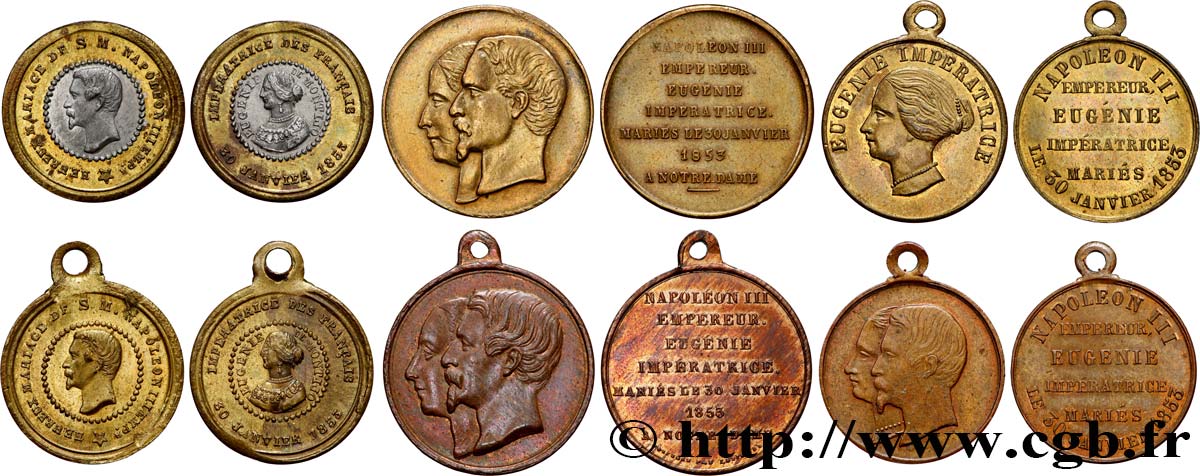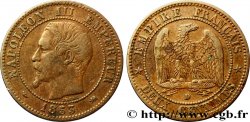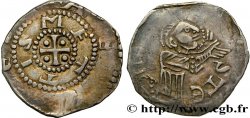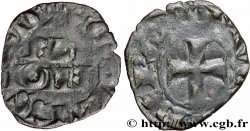fme_773351 - SECOND EMPIRE Lot de 6 médaillettes, Mariage de Napoléon III et Eugénie
80.00 €(Approx. 91.20$ | 68.00£)
Quantity
Add to your cart

Type : Lot de 6 médaillettes, Mariage de Napoléon III et Eugénie
Date: 1853
Metal : copper
Diameter : 27 mm
Orientation dies : 12 h.
Weight : 21,53 g.
Edge : lisse
Puncheon : sans poinçon
Predigree :
Cet exemplaire provient de la Collection Terisse
Obverse
Obverse legend : (DIVERSES LÉGENDES).
Obverse description : (divers avers).
Reverse
Reverse legend : (DIVERSES LÉGENDES).
Reverse description : (divers revers).
Commentary
-Médaillette, Mariage de Napoléon III et Eugénie, Avers : Têtes accolées à gauche; Revers : NAPOLEON III / EMPEREUR / EUGENIE / IMPERATRICE / MARIES LE 30 JANVIER / 1853 / A NOTRE-DAME. Cuivre rouge. Diamètre avec bélière : 27 mm, sans bélière : 23 mm. Poids : 4,19g
-Médaillette, Mariage de Napoléon III et Eugénie, Avers : Têtes accolées à gauche; Revers : NAPOLEON III / EMPEREUR / EUGENIE / IMPERATRICE / MARIES LE 30 JANVIER / 1853 / A NOTRE-DAME. Laiton. Diamètre : 23,5 mm, Poids : 5,06g. (Etat TB+, exemplaire nettoyé)
-Médaillette, Mariage de Napoléon III et Eugénie, Avers : Têtes accolées à gauche; Revers : NAPOLEON III / EMPEREUR / EUGENIE / IMPERATRICE / MARIES LE 30 JANVIER 1853. Cuivre rouge. Diamètre avec bélière : 24,5 mm, sans bélière : 20,5 mm. Poids : 3,30g. (Etat TTB+, Brillant de frappe visible)
-Médaillette, Mariage de Napoléon III et Eugénie, Avers : Tête de profil à gauche d’Eugénie; Revers : NAPOLEON III / EMPEREUR / EUGENIE / IMPERATRICE / MARIES LE 30 JANVIER 1853. Cuivre doré. Diamètre avec bélière : 24,5 mm, sans bélière : 20,5 mm. Poids : 3,36g. (Etat TTB+, Brillant de frappe visible)
-Médaillette, Mariage de Napoléon III et Eugénie, Avers : *HEUREUX MARIAGE DE S. M. NAPOLEON III EMP.R. Tête de profil à gauche de Napoléon III; Revers : IMPERATRICE DES FRANCAIS - 30 JANVIER 1853 // EUGENIE - DE MONTIJO. Buste habillé de profil à gauche d’Eugénie. Cuivre. Diamètre avec bélière : 24,5 mm, sans bélière : 20 mm. Poids : 2,85g. (Etat TTB+, Brillant de frappe visible)
-Médaillette, Mariage de Napoléon III et Eugénie, Avers : *HEUREUX MARIAGE DE S. M. NAPOLEON III EMP.R. Tête de profil à gauche de Napoléon III; Revers : IMPERATRICE DES FRANCAIS - 30 JANVIER 1853 // EUGENIE - DE MONTIJO. Buste habillé de profil à gauche d’Eugénie. Cuivre d’aspect bimétallique. Diamètre : 20 mm. Poids : 2,77g. (Etat TTB, Bélière retirée et usure sur les reliefs).
-Médaillette, Mariage de Napoléon III et Eugénie, Avers : Têtes accolées à gauche; Revers : NAPOLEON III / EMPEREUR / EUGENIE / IMPERATRICE / MARIES LE 30 JANVIER / 1853 / A NOTRE-DAME. Laiton. Diamètre : 23,5 mm, Poids : 5,06g. (Etat TB+, exemplaire nettoyé)
-Médaillette, Mariage de Napoléon III et Eugénie, Avers : Têtes accolées à gauche; Revers : NAPOLEON III / EMPEREUR / EUGENIE / IMPERATRICE / MARIES LE 30 JANVIER 1853. Cuivre rouge. Diamètre avec bélière : 24,5 mm, sans bélière : 20,5 mm. Poids : 3,30g. (Etat TTB+, Brillant de frappe visible)
-Médaillette, Mariage de Napoléon III et Eugénie, Avers : Tête de profil à gauche d’Eugénie; Revers : NAPOLEON III / EMPEREUR / EUGENIE / IMPERATRICE / MARIES LE 30 JANVIER 1853. Cuivre doré. Diamètre avec bélière : 24,5 mm, sans bélière : 20,5 mm. Poids : 3,36g. (Etat TTB+, Brillant de frappe visible)
-Médaillette, Mariage de Napoléon III et Eugénie, Avers : *HEUREUX MARIAGE DE S. M. NAPOLEON III EMP.R. Tête de profil à gauche de Napoléon III; Revers : IMPERATRICE DES FRANCAIS - 30 JANVIER 1853 // EUGENIE - DE MONTIJO. Buste habillé de profil à gauche d’Eugénie. Cuivre. Diamètre avec bélière : 24,5 mm, sans bélière : 20 mm. Poids : 2,85g. (Etat TTB+, Brillant de frappe visible)
-Médaillette, Mariage de Napoléon III et Eugénie, Avers : *HEUREUX MARIAGE DE S. M. NAPOLEON III EMP.R. Tête de profil à gauche de Napoléon III; Revers : IMPERATRICE DES FRANCAIS - 30 JANVIER 1853 // EUGENIE - DE MONTIJO. Buste habillé de profil à gauche d’Eugénie. Cuivre d’aspect bimétallique. Diamètre : 20 mm. Poids : 2,77g. (Etat TTB, Bélière retirée et usure sur les reliefs).








 Report a mistake
Report a mistake Print the page
Print the page Share my selection
Share my selection Ask a question
Ask a question Consign / sell
Consign / sell
 Full data
Full data














